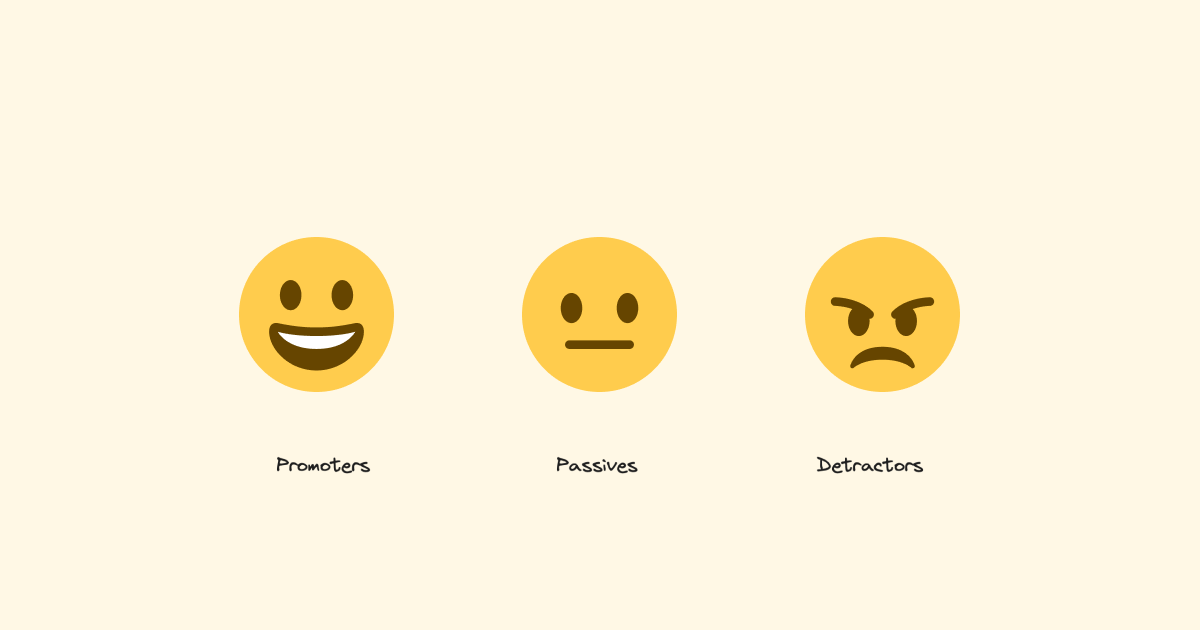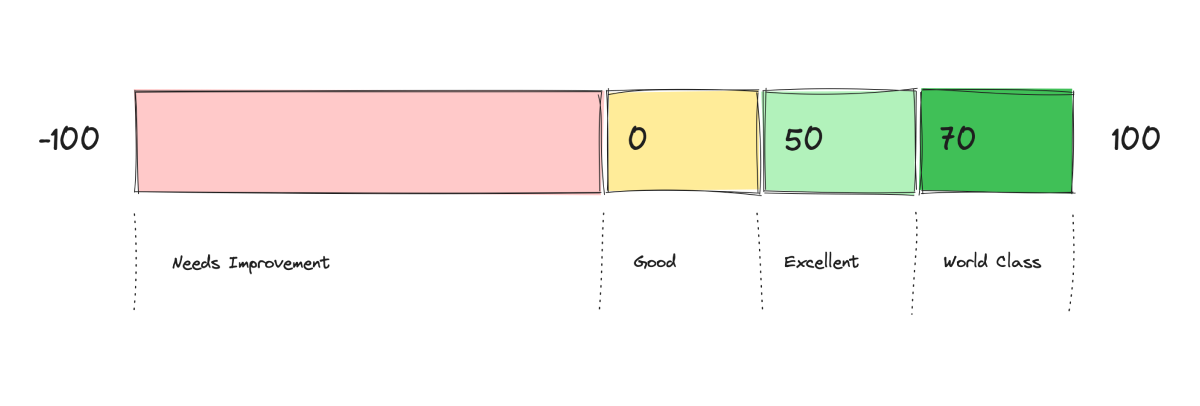If you spend any time in the business, startup, or marketing world, you've probably heard of the Net Promoter Score, or NPS. It's a common metric used by many companies, from startups to Fortune 500 companies, to measure customer satisfaction and loyalty. In this blog post, I'm going to explain what NPS is, how it's calculated, what it means, and how you can improve it.
What is NPS?
The Net Promoter Score is a simple yet powerful tool that divides your customers into three camps: the promoters, the passives, and the detractors.
Your promoters are your loyal customers who love your product! They are the ones who are ready to recommend your product to everyone they meet. They are the ones who will leave you a 5-star review, and they are the ones who will stick with you through thick and thin.
The passives are the ones enjoying the ride but not quite ready to recommend your product to their friends. They are quite happy with your product, but they are not in love with it. They are the ones who will leave you a 3-star review, and they are the ones who will leave you if a better product comes along.
Finally, we have the detractors. These are the customers who aren't happy with your product. They are those snarky customers who will leave you a 1-star review and are ready to discourage others from using your product.
Here's a simple diagram to help you visualize the three camps. 😂

What is the Net Promoter Question?
Now that we know what the three camps are, let's see how we can calculate the Net Promoter Score for our product. At this point, you might be thinking, "I can just ask my customers if they are promoters, passives, or detractors, right?" Well, you can, but that's not how NPS is calculated. Instead, you ask your customers a simple question: "How likely are you to recommend our product to a friend or colleague?" and ask them to rate their answer on a scale of 0 to 10.
Something may have clicked in your head at this point. You've seen this question before, haven't you? That's right, it's a very simple question and is the basis of the Net Promoter Score. Now that we have the answers to our question, we can calculate the NPS by subtracting the percentage of detractors from the percentage of promoters.
How is NPS calculated?
Alright, let's see how this works with an example. Let's say we have 100 customers, and we ask them the question, "How likely are you to recommend our product to a friend or colleague?" and ask them to rate their answer on a scale of 0 to 10.
Once we have the answers, we categorize them into three camps: promoters, passives, and detractors. Usually, we consider anyone who answers 9 or 10 as promoters, anyone who answers 7 or 8 as passives, and anyone who answers 0 to 6 as detractors.
Now that we have the three camps, we can calculate the NPS by subtracting the percentage of detractors from the percentage of promoters. In our example, we have 100 customers, 50 of them are promoters, 30 of them are passives, and 20 of them are detractors. So our NPS is 50% - 20% = 30%.
Here's the formula for calculating the NPS: NPS = % Promoters - % Detractors
Net Promoter Score Calculator
I thought it would be a good idea to include a Net Promoter Score Calculator on this page so that you can calculate the NPS for your product. You can use this calculator to calculate the NPS for your product. All you have to do is enter the number of promoters, passives, and detractors, and the calculator will calculate your Net Promoter Score (NPS) for you.
What is a good NPS?
Now that we know how to calculate the NPS, let's see what a good NPS is. The NPS can range from -100 to 100. A positive NPS means that you have more promoters than detractors, and a negative NPS means that you have more detractors than promoters. A score of 0 means that you have an equal number of promoters and detractors.
There is no universal or specific benchmark for a good Net Promoter Score for all industries such as SaaS. However, generally, a positive NPS score, anything above 0, is considered good. A score of 50 or above is considered excellent, and a score of 70 or above is considered world-class.
Here's a chart to help you visualize the different NPS scores:

Be careful of the sample size
When calculating the Net Promoter Score, you need to be careful of the sample size. Generally, the NPS score is significantly influenced by a few dissatisfied or extremely satisfied customers, which may not accurately represent the overall customer sentiment. For example, if you have 1,000 customers and only 10 of them answer the NPS question, then the NPS score will be significantly influenced by those 10 customers.
Therefore, when using the Net Promoter Score, or in general, any survey or questionnaire to measure different aspects of your business, you need to make sure that you have a large enough sample size to get an accurate representation of your customers' sentiment.
Why is NPS important?
Alright, we've gotten pretty far in this blog post, but you might be wondering, "Why is NPS important?" Well, the Net Promoter Score tells us quite a lot about our business:
-
It is one of the easiest ways to measure customer satisfaction. It's a simple question that can be answered in a few seconds, and it gives us a good idea of how our customers feel about our product.
-
It is a good predictor of growth. The Net Promoter Score is a good predictor of growth because it tells us how likely our customers are to recommend our product to others. If our customers are happy with our product, they will recommend it to others, which will lead to more customers and more growth. Word of mouth, baby!
-
It identifies and highlights what we need to improve. The Net Promoter Score tells us what we need to improve to make our customers happier. It tells us what we are doing right and what we are doing wrong.
-
It identifies loyal customers and is a good indicator of customer retention. It tells us who is ready to recommend our product to others. It tells us who is ready to stick with us through thick and thin. It tells us who is ready to leave us if a better product comes along.
How to improve your NPS?
So, now that we know what the Net Promoter Score is and how we can calculate it, let's see how we can improve the NPS for our product. Here are a few tips to help you improve your NPS:
-
Deliver Exceptional Customer Service. This is by far the most important thing you can do to improve your NPS. If you deliver exceptional customer service, your customers will be happy with your product, and they will recommend it to others. You would be surprised how fantastic customer support can become a moat for your business.
-
Ask your customers for feedback. Continuously asking your customers for feedback is a great way to understand what they like and what they don't like about your product, and it's a great way to improve your product. When you ask your customers for feedback, you show them that you care about their opinions, and you show them that you are willing to listen to them.
However, sometimes, collecting feedback and interpreting feedback can be a bit tricky. I will write a separate blog post on this topic, but for now, I will leave you with this: when collecting feedback, make sure that you ask the right questions, and when interpreting feedback, make sure that you don't take it personally. -
Make it easy for your customers to contact you. You see, a lot of times, customers don't contact you because they either don't know how to contact you or it may feel like a hassle to contact you. Depending on your product and your business, you can find creative ways to make it easy for your customers to contact you. For example, if you have a SaaS product and your users are developers, you can integrate your product with Slack and make it easy for your users to contact you via Slack. If you have a product with a customer base that is very active on Twitter, you can make it easy for your customers to contact you via Twitter.
-
Follow up with your customers. Following up with your customers is a great way to show them that you care about them and that you are willing to listen to them. It's a great way to build a relationship with your customers and to make them feel special. Whenever you get a new customer, feedback, or a feature request, add it to your reminder list to follow up with them within a few days.
Wrapping up
Alright, that's it for this blog post. I hope you found it useful and that you learned something new. Feel free to check out our other blog posts on our blog. If you have any questions or feedback, please feel free to contact me through our contact email or Twitter. I would love to hear from you!
Interested in LogSnag?

